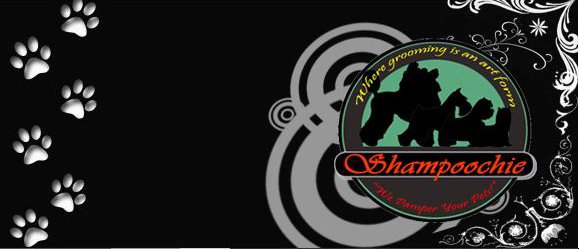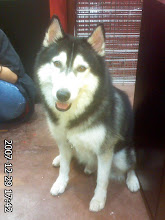About Shampoochie Pet Salon - Holistic Pet Centre

- Holistic Pet Centre
- Singapore
- We strongly believe that our pets should be treated with the same respect for natural living that we give ourselves. A holistic approach to health care for dogs and cats is important for them to live life to its fullest, and for us to get the most out of their company. Call us at 91003489
Saturday, November 1, 2008
We have moved
We have moved out of Ericsson Pet Farm due to certain circumstances. Thanks to many of our loyal pet lovers to have the same belief in us as a Holistic Health Care for your pets.
Our new address is Blk 326 Woodlands St 32 #01-109.
Please continue to support us. We are hoping to see you soon on our opening ceremony on the 10 Nov 2008 1pm.
Monday, October 27, 2008
Canine Parvovirus Type 2c in the United States
The press release is based on the results of a study published by Dr. Kapiland his colleagues in the Journal of Clinical Microbiolgy2. In this study,tissue and fecal samples were collected between February 2006 and August2007 from 54 dogs with confirmed CPV infections. Canine parvovirus type 2c wasidentified in 48% of the dogs while CPV-2b was identified in 46% of thedogs. The researchers also that 66% of the dogs infected with various strains ofCPV had previously received a vaccination.
Since implications of the press release are so frightening, we must digdeeper into the CPV-2c story to fully understand what it means for dog ownersand breeders. The emergence of this new strain of CPV is not surprisingconsidering the history of CPV and the high rate of viral evolution associatedwith its initial emergence in the 1970s. Since the emergence of CPV type 2(CPV-2) in the 1970s the virus has mutated. The v irus mutated into 2 strainsknown as CPV-2a and CPV-2b. In 2000 scientists in Italy were the first toreport the emergence of CPV-2c in dogs. Since that report, CPV-2c has beenreported in Western Europe, Asia, and South America.
Now that a new strain of CPV is present throughout the world, the questionarises: What is meant by the term new strain? We need to realize that theterm new strain actually means genetic variant. In order for a strain ofparvovirus to be labeled a new strain, at least 1 of its approximately 5000nucleotides must be different from a previously identified strain. This is thecase of the CPV-2c identified in the United States. Genetically speaking,CPV-2c differs from CPV-2b by only a few nucleotides. In other words, from agenetic standpoint, the new strain(CPV_2c) is over 99% identical to the oldstrain (CPV-2b).
So there is very little genetic difference between CPV-2a, CPV-2b, andCPV-2c. Does this sligh t genetic variation make CPV-2c biologically differentfrom CPV-2a or CPV-2b? The most prolific researcher of CPV-2c in Italyconcluded in a research report that CPV variants (2a, 2b, and 2c) have similarbiological behaviors3. In that research report, tissue distribution of CPV wassimilar across all 3 genetic variants of CPV. Canine parvovirus type 2a,2b, and 2c were all found in the intestines and in the heart. So the fact thatCPV infects the heart and the intestines is not new information and is notspecific to only CPV-2c. In another paper that investigated the occurrenceof CPV-2c in the United States, researchers stated that dogs infected withCPV-2c exhibited clinical signs and outcomes that were similar to dogs infectedwith CPV-2a and CPV-2b4. So death of dogs due to CPV infection (be it 2-a,2-b, or 2-c) is not new information and it is erroneous to suggest thatCPV-2c is more lethal then older CPV strains.
Since CPV-2c has been discovered in the United Stat es, what are dog ownersand breeders to do? According to the press release, new vaccines should beformulated since previously vaccinated dogs have contracted CPV-2c. Shouldyou switch vaccines? Should you demand vaccine manufacturers make a newvaccine that protects against CPV-2c? The answer to the 2 previous questionswould be yes if we did not have some suitable vaccines currently available foruse. With the information now available in the scientific literature, Ibelieve that there is no reason to suggest that the currently available effectivevaccines will not protect against CPV-2c. Let me explain why I believe thisto be true.
First, a recent research report indicated that one of the original modifiedlive CPV vaccines (based on an old strain of CPV) was protective againstCPV-2c. This study reported that after CPV-2c challenge, vaccinated pups did notbecome ill while unvaccinated pups showed clinical signs of canineparvovirus5. In other words, on of the fir st vaccines, which was formulated yearsbefore CPV-2c was identified, was able to induce protection against this newgenetic variant known as CPV-2c.
Second, certain effective CPV vaccines protect puppies against both CPV-2aand CPV-2b. Since there is very little genetic variant and no knownbiological differences between CPV-2a, CPV-2b, and CPV-2c, why wouldn't theseeffective CPV vaccines protect against CPV-2c? To my Knowledge, no one has data todefinitively answer the question posed above.
Third, NEOPAR© has been tested in a kennel in Oklahoma where this newgenetic variant was diagnosed by the Oklahoma Animal Disease DiagnosticLaboratory. NEOPAR©, when used properly, stopped the CPV-2c in its tracks just likeit stops a CPV-2a and CPV-2b outbreak.
One disturbing aspect of the press release and Dr. Kapil's paper was thatvaccines do not protect against CPV-2c. In Dr. Kapil's study, 66% of the dogswere previously vaccinated. It is important to rea lize that not allvaccines stimulate protection after just one, or multiple, doses. Immunity is oftennot stimulated by vaccination if the animal is stressed, has a suppressedimmune system, or if the vaccine used is sub-potent (few vaccine particlesper dose). Unfortunately, the complete vaccination history for each dog in DrKapil's study was not provided. So, it is possible these dogs could havebeen vaccinated after they were exposed to CPV or they may have been vaccinatedwith a sub-potent vaccine prior to CPV exposure. Many sub-potent vaccinesare on the market today and were not formulated to work in the face of thehigh level of maternal antibody when pups are first vaccinated at 5 to 7 weeksof age. This high level of maternal antibody can render a sub-potentvaccine ineffective. Another important point of Dr. Kapil's study to consider isthat vaccinated dogs were infected with CPV-2b and CPV-2c. Of the 36vaccinated dogs in which CPV was identified, type 2b was presen t in 15 dogs and type2c was present in 19 dogs. So, not only did vaccination fail to protectthese dogs against CPV-2c, vaccination also failed to protect them against theolder genetic variations of CPV. Clearly, vaccines do not immunize 100% ofvaccinated dogs and this is also not new information.
At the present time, we know very little about CPV-2c. However, informationpresent in the scientific literature suggests that CPV-2c is very similarto CPV-2a and CPV-2b; and, that vaccines developed prior to the discovery ofCPV-2c protect dogs from CPV-2c challenge. Even though the full CPV-2c storyhas not yet been established, this has not stopped people from makingpredictions of doom and gloom. Lets not get bogged down by the press releaseintended to whip up hysteria in hopes of creating an economic opportunity for aresearch institution. Let's wait until we have more relevant facts aboutthis genetic variant before we recommend changing the existing vaccinationprotoc ols that have been so successful for so many years. In essence, all thatDr. Kapil's report stated is that CPV-2c (along with other old geneticvariants of CPV) has been identified in previously vaccinated dogs in the UnitedStates. So the implications of the press release of widespread death due toan extremely pathogenic new strain of CPV are a bit far reaching. Let me beclear. Dr. Kapil's study is scientifically sound and the results are clearand straightforward, but the press release is an exaggeration of what isknown and speculates on what we do not know.
References
1 _http://www.cvhs.okstate.edu/index.php?o_(http://www.cvhs.okstate.edu/index.php?o) .. itemid=291_<http://www.cvhs.okstate.edu/index.ph...k=view&id= 437&itemid=291>_ (http://www.cvhs.okstate.edu/index.php?option=com_content&task=view&id=437&item id=291)
2Kupil, S., Cooper, E., Lamm, C., Murry, B., Rezabek, G., Johnson III, L.,Campbell, G., Johnson, B. 2007 Canine Parvovirus types 2c and 2bcirculating in North American dogs in 2006 and 2007. J. Clin. Microbial.,45(12):4044-4047
3Decaro, N., Martella, V., Elia, G., Desario, C., Campolo, M., Lorusso, F.,Colaianni, M. L., Lorusso, A., Buon-avoglia, C. 2007 Tissue distribution of the antigenic variants of canineparvovirus type 2 in dogs. Vet Microbial. 2007 Mar 31 1;121(1-2):39-44
4Hong, C., Decaro, N., Desario, C., Tanner, P., Pardo, M.C., Sanchez, S.,Buonavoglia, C., Saliki, J.T. 2007 Occurrence of canine parvovirus type 2c inthe United States. J. Vet. Diagn. Invest. 19:535-539
5Spibey, N., Greenwood, N.M., Sutton, D., Chalmers, W.SK., Tarpey, I. 2008Canine parvovirus type 2 vaccine protects against virulent challenge withtype2c virus. Vet. Microbiol. Apr 1;128(1-2):48-55. Epub. 2007 Oct 2.
Canine Parvovirus Type 2c in the United StatesDr. Ben Hatler, NEOTECH, LLC
Alert: New Strain of Parvo
From: Wendy Swift DVM, Veterinary Medical Director of the HSKC
Date: August 20, 2008
Re: Please Read!!!!!! New Parvo Strain Hits West Michigan
Parvo 2c has been suspected as the cause of death for at least three adult canines in Kent County and surrounding areas. Two of the three dogs had a known previous vaccine history and tested positive on the Idexx Snap Parvo Test. The most current information on Parvo 2c from the vaccine/shelter medicine specialists around the country is as follows:
Disease: Parvo 2c is a highly virulent strain of the parvo virus that is extremely fatal in puppies and adult dogs. This strain of parvo attacks the circulatory organs approximately 24 hours before attacking the gastrointestinal tract. Therefore, by the time a dog is presented for lethargy, vomiting, and diarrhea it is generally too late.
Diagnosis: Parvo 2c is detectable on the Idexx Snap Test, but it has been showing as a weak positive on many tests. Viral isolation is the best way to confirm the diagnosis, but it is not going to assist with diagnosis upon presentation.
Treatment: Conservative treatment with supportive care has been rarely successful. Plasma transfusions from recovered dogs have shown to yield the best treatment success at around 64% survival rate.Prevention: Schering-Plough (SP) and Intervet vaccinations have been proven to be 100% effective in preventing this strain of parvo. If you have any questions in regards to SP vaccinations please call 1-800-224-5318 (SP technical support). Fort Dodge vaccines were effective in less than 90% of the tested dogs/puppies, Pfizer was less than 70% effective in preventing disease, and Merial was less than 50% effective. This data was obtained from an independent source, and at this time the only published data is an article from Schering-Plough (S/P).
Cleaning Protocols: There are only two products that kill this virus with a ten minute contact time. Trifectant and bleach (1/2 cup/gallon dilution) will successfully kill Parvo 2c. All other products that claim to kill parvo are not effective per Dr. Hall (Vaccination/ Shelter Specialist at SP) !!!!!!
Prognosis: The prognosis is extremely poor. Most puppies or dogs die acutely from the cardiac components of the disease process. If GI signs are present, the disease has progressed and is most likely fatal.
Please feel free to call me with any questions (616) 791-8218. Over seven veterinary clinics have seen this type of disease locally. The citizens of Kent County need to be aware of the risk associated with this disease. Please inform your clients and protect the canines in your area.
Sunday, October 19, 2008
What Your Dog Wants You to Know
If your dog could talk, these are some of most important things she would like to tell you…

1 - My life will probably only last 8 to 15 years. It will hurt me more than you know if I have to be away from you for longer than a day or two.
2 - If you have patience with me and give me time to learn what you would like from me, I can promise you, you will never be disappointed.
3 - Trust me with your life and have faith in our future together. If I don't feel that you honestly believe in me, I will suffer great emotional stress. My sense of self-worth is totally dependent upon your confidence in me.
4 - Don't stay mad at me for long or confine me to a cage to punish me. You have your friends, your job, and your recreation. I HAVE ONLY YOU!
5 - Talk to me about anything you want as frequently as possible. Even if I can't comprehend your precise words, I can understand the meaning of what you're telling me by the tone of your voice.
6 - Remember no matter how you treat me, I will NEVER forget it.
7 - When you consider raising your hand to hit me, remember I have teeth that could break the bones in your hand, but I choose not to bite you.
8 - Before you scream at me for failing to respond to your commands as I usually do, take time to think about what might be wrong with me that would cause me to treat you differently. Maybe I haven't been eating right or drinking enough water. Or maybe my age is catching up with me and I just can't do what I used to do.
9 - Take good care of me when I get old. Someday you will be as old as me and you will see how it feels.
10 - Be there for me through good times and bad. Never say you can't handle taking me to the vets for stitches or surgery. Nothing could make me feel worse. Everything in my life is easier for me to deal with when I have you standing by my side. Remember my love for you is unconditional and it will last for your entire life.

Danielle Hollister (2000)Danielle Hollister is the Writing Host at BellaOnline http://www.bellaonline.com/career/writing.html and Publisher of BellaOnline's Writing Zine http://www.egroups.com/group/bellaonlinewriting to subscribe send email to: bellaonlinewriting-subscribe @ egroups.com
If you like this lovely piece as much as I do, leave your comments below!
Saturday, October 18, 2008
Shampoochie Grooming Photos
Solid Gold recalls "Tiny Tots" treats
--------------------------------------------------
I was just alerted to the following recall:http://solidgoldhealth.com/news/
Tiny Tots Dog Treat Voluntary Product Withdrawl
October 13, 2008
Due to some instances of mold growth in a single batch of Tiny Tots, we have decided to voluntarily withdraw the entire production run from the market. We would like to assure our customers that there have been no reported serious health effects on dogs that have consumed Tiny Tots from this batch.
If you have a bag of Tiny Tots with a Best Before date of April 2009, please return it to your retail store for a full refund. No other batches of Tiny Tots or any of our other jerky treats are affected.
Solid Gold is committed to producing the healthiest food, treats, and supplements for your pet. As always, if you have any questions or concerns please contact us at 800-364-4863 or online at dane@solidgoldhealth.com.
Upcoming changes to Canidae formulations
-----------------------------------------------------------
I wanted to give a heads up to dog owners feeding Canidae products about a few details that the makers of this product aren't telling you in their sales pitch for their changed formulas:
Under the new formulation, Canidae dry foods will no longer be gluten free, due to the addition of barley. If you know that your dog is gluten intolerant, start shopping around for a different food.
Even if your dog doesn't have problems with gluten (not all do, and many foods do contain high-gluten grains like barley), the change in formulation to include rice bran and peas may contribute to gas and digestive upset. Dogs who aren't particularly sensitive may not have any problems at all, others will get over it within a few days of transitioning, but again, for individuals with a delicate digestive system, expect that they may no longer tolerate the product.
Millet is generally well tolerated, but again, it doesn't work for every dog.
"Diversifying" ingredients may sound catchy, and Canidae certainly has made an effort to put a positive spin on it in their statement, but please remember that not all dogs do well on foods that include a wide variety of items.
Also note that "Herring Meal" will be replaced by generic "Ocean Fish Meal", meaning the company reserves the possibility to use different fish from batch to batch without having to change the ingredient list. This has not been addressed in their statement at all.
Whether these changes are indeed an improvement, as Canidae claims, is for you to decide - after observing how it affects your dog.
Canidae All Lifestages
Old Formula: http://canidae.com/dogs/all_life_stages/dry.html
New Formula: http://canidae.com/dogs/all_life_stages/dry2.html
Canidae Platinum
Old Formula: http://canidae.com/dogs/platinum/dry.html
New Formula: http://canidae.com/dogs/platinum/dry2.html
Canidae Chicken & Rice(Note that after the change it's no longer going to be a true "Chicken and Rice" formula, but instead a "Chicken, Rice, Barley and Peas" formula)
Old Formula: http://canidae.com/dogs/chicken-and-rice/dry.html
New Formula: http://canidae.com/dogs/chicken-and-rice/dry2.html
Canidae Lamb & Rice
New Formula: http://canidae.com/dogs/lamb-and-rice/dry.html
The old formula has already been overwritten. "Lamb and Rice" formula will now also be a misnomer - even though it's legal as far as labeling regulations go. This is the current ingredient list:
Lamb Meal, Brown Rice, Canola Oil (preserved with Mixed Tocopherols), Flax Seed, Sun cured Alfalfa Meal, Sunflower Oil, Lamb, Lecithin, Potassium Chloride, Choline Chloride, Linoleic Acid, Rosemary Extract, Sage Extract, Dried Enterococcus Faecium Fermentation Product, Dried Lactobacillus Acidophilus Fermentation Product, Dried Aspergillus Oryzae Fermentation Extract, Dried Bacillus Subtilis Fermentation Extract, Inulin (from Chicory Root), Saccharomyces Cerevisiae Fermentation Solubles, L-Lysine, Taurine, Yucca Schidigera Extract, Mixed Tocopherols (source of Vitamin E), Zinc Amino Acid Chelate, Manganese Amino Acid Chelate, Iron Amino Acid Chelate, Copper Amino Acid Chelate, Cobalt Amino Acid Chelate, Vitamin A Supplement, Vitamin D3 Supplement, Ascorbic Acid (source of Vitamin C), Niacin, Thiamine Mononitrate (Vitamin B1), Riboflavin (source of Vitamin B2), Beta Carotene, Calcium Pantothenate, Pyridoxine Hydrochloride (Vitamin B6), Calcium Iodate, Folic Acid, D-Biotin, Organic Selenium, Dried Papaya, Dried Pineapple, Vitamin B12 Supplement
Timberwolf voluntarily recalls Ocean Blue and Dakota Bison Formulas
--------------------------------------------------------
It seems that after the recently "discovered" formula discrepancies, there's another problem with Timberwolf products:
Dakota Bison/Ocean Blue Reported Issues
Timberwolf Organics Customer,
Due to recent reports from some customers, we have ordered that two formulas from three specific dates be pulled from the shelves. These are:
Dakota Bison with 'best by date' of 12 Feb 2009
Ocean Blue with 'best by date' of 20 Feb 2009
Ocean Blue with best by date' of 8 March 2009
The reported symptoms include dogs refusing to eat, diarrhea or vomiting. While the problem is inconsistent (not every dog eating food from those dates/bag show the symptoms and not every bag), to err on the side of caution have decided to pull the formulas produced with the above dates. Initial testing has come back negative for problems and further testing is pending results.
As soon as the cause of this reported problem is determined procedures will be put into place to ensure that an event like this cannot happen again. Please be assured that no other formulas and Ocean Blue and Dakota Bison with dates other than ones listed above are not affected.
We apologize for any inconvenience or problems that this may have resulted in. If you do have a bag with those dates please contact the retailer you purchased it from for an exchange or credit. If you purchased it directly from us please give us a call or email us at customer.support@timberwolforganics.com.
Thank you for choosing Timberwolf Organics.
Sincerely,
Timberwolf Organics Team
Tuesday, October 14, 2008
Should I Groom My Cat?
Cats are meticulous groomers, most spending their days licking and grooming themselves. A cats tongue is the perfect tool for grooming. Not only does it keep the fur clean, but it also massages their skin and stimulates good circulation. However, no matter how much your cat grooms himself, you should also groom your cat daily. Why?
Grooming enhances the bond between you and your cat, and also lets kitty become used to being handled. Another advantage of grooming is that brushing will remove loose hair, reducing the risk of hairballs. Many cats have difficulty dislodging hairballs which can cause blockage of the intestines. This can be life-threatening. Grooming also gives you the opportunity to check the skin for lumps, cuts and irritations and for fleas and parasites.
How To Groom Your Cat
Introduce your cat to grooming at as young an age as possible. Groom your cat when he is tired and when you are most relaxed. At a start, groom a little each day so your cat can become used to it gradually without becoming too stressed. Praise and spoil him after each grooming session. This helps to create a tighter bond between you and your pet and will make grooming and brushing easier in the future. Use a grooming mitt or glove at first and then progress to a brush or comb when your kitty has become used to the handling. Start brushing along the cat’s back, going from his head to his tail. Do this a few times on one side, and then switch to the other. Each area should be brushed a few times in the direction of the hair growth.Avoid brushing his face and paws.
Grooming Short-haired Cats
Short-haired cats should be groomed with a rubber brush. Wet or dampen the brush to help catch any loose fur and prevent it from flying around your home - especially important if anyone in the household is allergic to cat hair.You can also use a flea comb on short haired cats. These are brushes with very narrowly placed teeth to scrape up the fleas. Start combing small lengths at a time, gently, from the skin out. Dip any fleas found into a bowl of soapy water. To give a shine to the cat’s coat, finish with a grooming glove or slicker brush.
Grooming Long Haired Cats
Use a comb to groom the hair of a long haired cat. Begin combing in your cat’s favourite spots - usually the chin and head. Then, go on to the next area. If there are any matted areas, try gently untangling the hair but you may have to cut it out with blunt tipped scissors.
Follow these simple steps:
First take a medium or course comb and split your cat’s coat into different sections. Be sure to work through the fur in a gentle and slow manner.Next, do exactly as you did in step one but this time use a fine-toothed comb.Follow through now with a good brushing, still working with small sections at a time. This time use a pin brush and work against the grain of the fur.
Once your cat gets used to grooming he will look forward to it each day and the brushing can be very relaxing and de-stressing for you as well!















